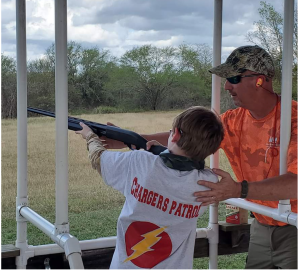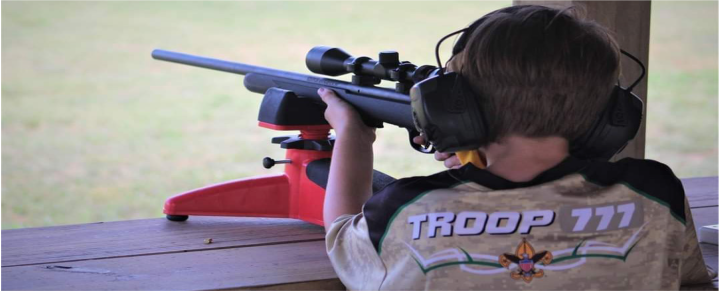This is Dawn Kotalik’s story of how her son, a Scout with cerebral palsy, participated in shooting sports in the Sam Houston Area Council (SHAC) and earned shooting sports merit badges. This was originally published in the Spring 2023 issue of the NRA Club Connection. The story has been lightly edited.

Our youngest son, Reed Kotalik, is a Star Scout with Troop 777. He will soon be 12 years old. Since he was a toddler, Reed looked forward to being a Boy Scout. His older brothers are all Eagle Scouts, along with dad John.
When Reed was 4 years old, he was diagnosed with Cerebral Palsy (CP) after extensive medical intervention as a baby. He was born with laryngomalicia, lacking cartilage in his throat to keep it structurally sound. During his critical first year, his brain was deprived of oxygen as a result of this condition. Soon after his 1st birthday, specialists at Texas Children’s performed surgery to create a functioning throat for Reed. Extensive feeding, speech, and other therapy followed.
We “lone scouted” Reed through Cub Scouts and Webelos because for years he had regular EEGs, cardiac monitoring, sleep studies, MRIs, therapy and invasive intervention. Reed realized (and embraced) through the years that most things would be a challenge for him and that rising to those occasions is necessary to have some sense of normalcy. Before his 5th birthday, we were offered (and declined) a handicap parking pass for him. Perseverance has become a way of life.
When Reed bridged from Webelos to Boy Scouts, we knew he would do his best, but we worried that he would be limited on some of the adventures that were possible (that his older brothers and dad have experienced).
Just last year, he was diagnosed with Cortical Visual Impairment (CVI) after his optical issues became more apparent. The area of his brain that is most impacted by Cerebral Palsy houses important vision function. CVI isn’t an eye issue that can be corrected with glasses. It is a decreased visual response due to a neurological condition and involves disrupted messages between Reed’s eyes and brain that interprets what he sees and then how his brain directs the reaction. Coupled with leg inversion and muscle weakness from CP, we knew that we would need to provide adequate support to keep Scouting fun and safe for him. While John and older brother Rafe have committed themselves to that task, we knew that we would need others to “become a Scouting village” for Reed. As a family, we deeply value the importance of Scouts learning to work within patrols, troops, and with other adult leadership as part of their journey.
Reed has found ways to adapt in his other pursuits. In lacrosse, he uses the green field as a backdrop to scoop up the white blur of a ball. On the track, the white lines are thicker and skewed, so Reed works to stay in the thin color of the lanes. White is a difficult color for Reed to work with. It easily reflects light and casts an immediate glare for him. It shuts down critical visual response from his brain. We were confident that he would do his best to adapt in Scouting, but knew that support from other Scouters would be as valuable.
When we asked Reed (at the start of his Scouts BSA journey) what merit badges he wanted to take, he chose several that concerned us including the shooting sports ones. We knew that some of his selections had higher physical demands, but we were determined to give him the opportunities for those too. We respected that this was his journey and not our own.
Getting started with Shooting Sports
Because John and Rafe were familiar with the qualification guidelines for shotgun, rifle, and archery, there was a concern that Reed may feel extremely defeated if he was unable to visualize the target and find a way to adapt to be successful.
We offered Reed the opportunity to work in a smaller group setting as an introduction to the Shooting Sports merit badges. We believe that provided a smooth and comfortable start for Reed. He enjoyed the small session of shotgun basics and a Hunter’s Education course with his troop at a unit level camp.
As summer merit badge workshops became available last summer, we allowed Reed to register for rifle shooting. When he reported for class that day, he did not want to alert instructors as to his unique needs. We respected that he wanted to try and adapt on his own. He spent the first half of the day trying to qualify on the usual white-based target. As the afternoon continued, we could see that he was straining to visualize the targets and knew that type of strain usually results in further eye deterioration.

At that point, we shared information with Chip Locke and other shooting instructors for SHAC. They quickly began to explore a way to make a custom, adaptive target from their available materials that was blue-based (a shop towel) with orange round stickers. Reed (and we) were so touched that they found a solution to provide a target that was not on white paper. He qualified using the adaptive target and earned his first shooting sports merit badge that day!
Since that time, Reed has continued to work with the range’s wonderfully supportive shooting sports staff. He has earned the Shotgun and Archery badges now. The orange clays worked well for him against a backdrop of the sky.
Our family deeply appreciates the understanding provided to Reed to explore an adaptive solution that satisfied the same qualification standards so that he could find success with his peers.
Reed now has a passion for shooting sports. While he continues to work to qualify on the shooting badges, I am confident he will have continued support from his team. They are clearly setting a standard of being considerate and inclusive of those with various challenges.

You must be logged in to post a comment.